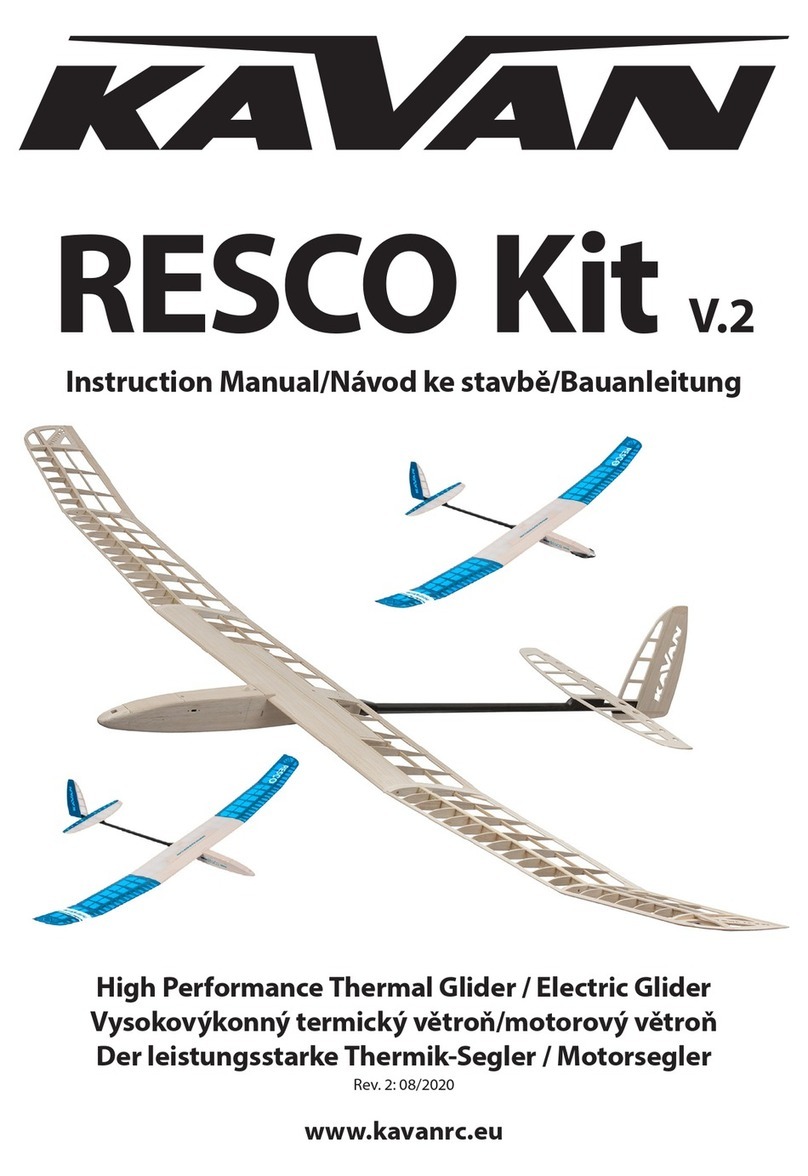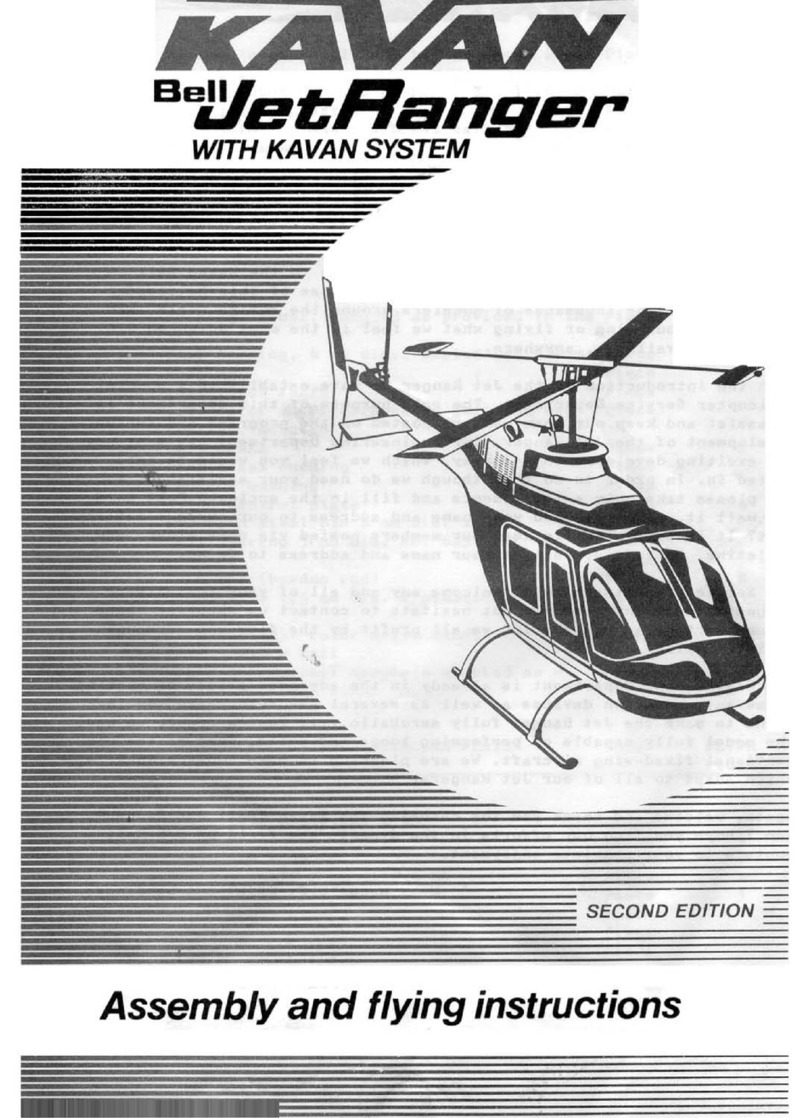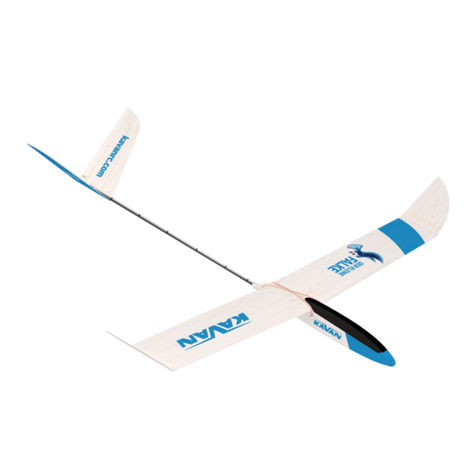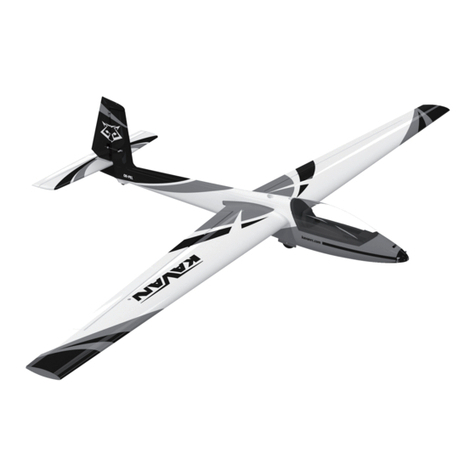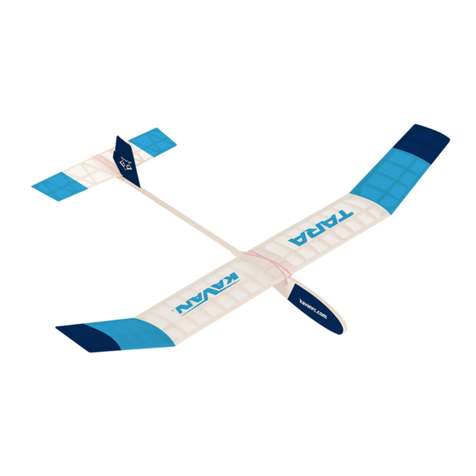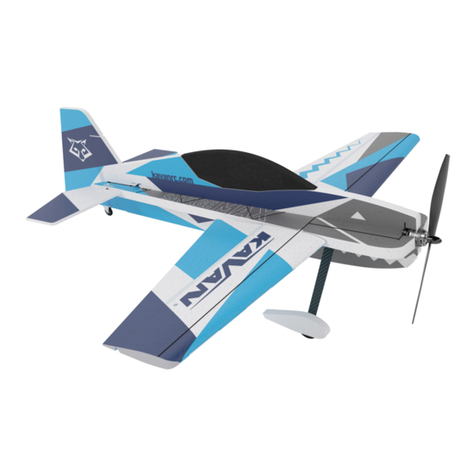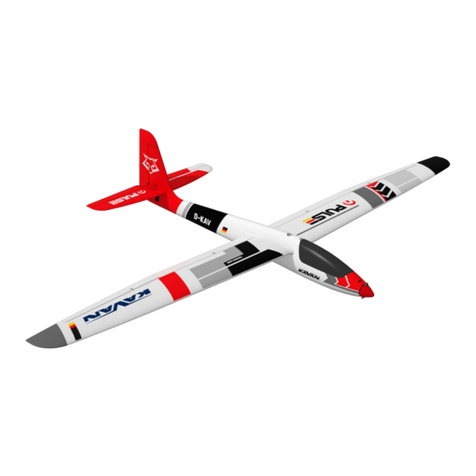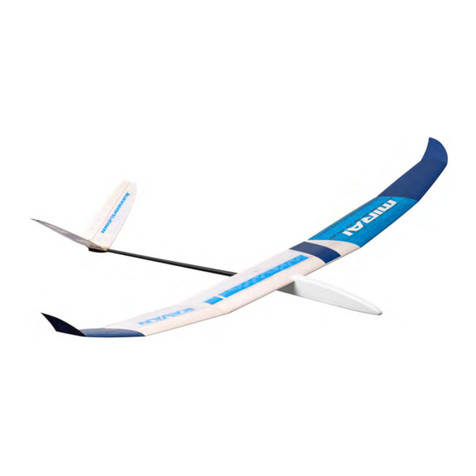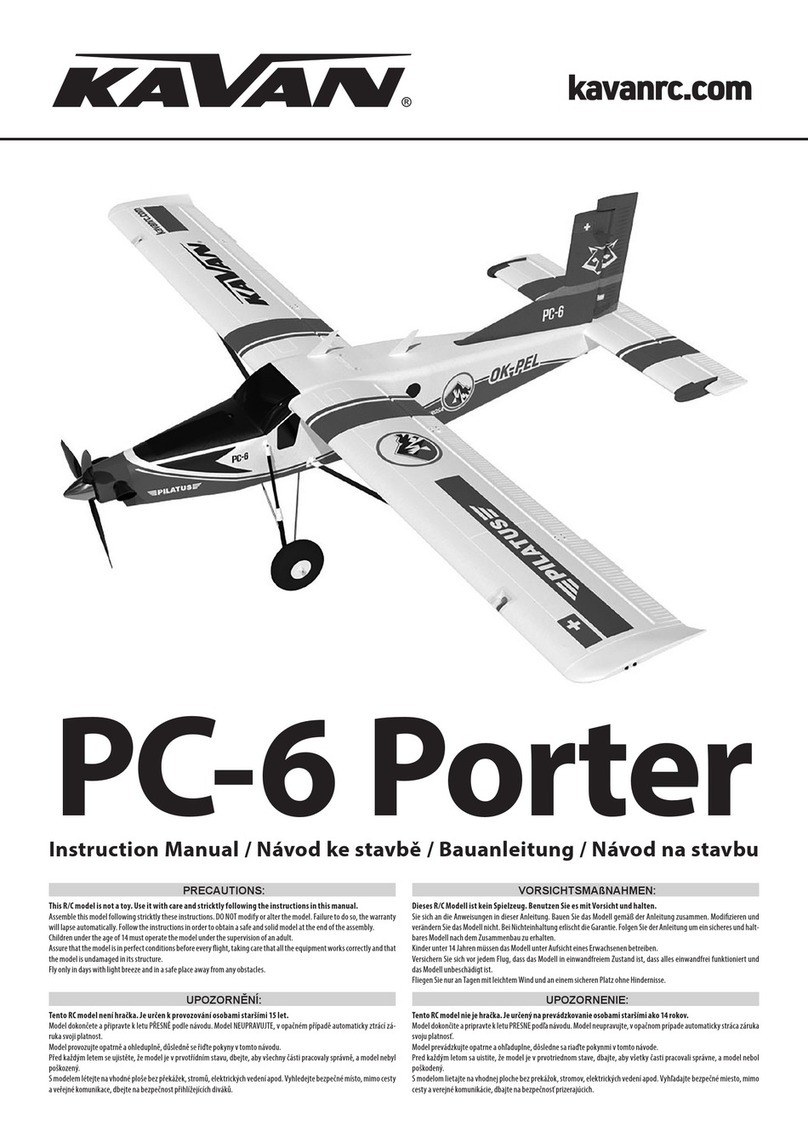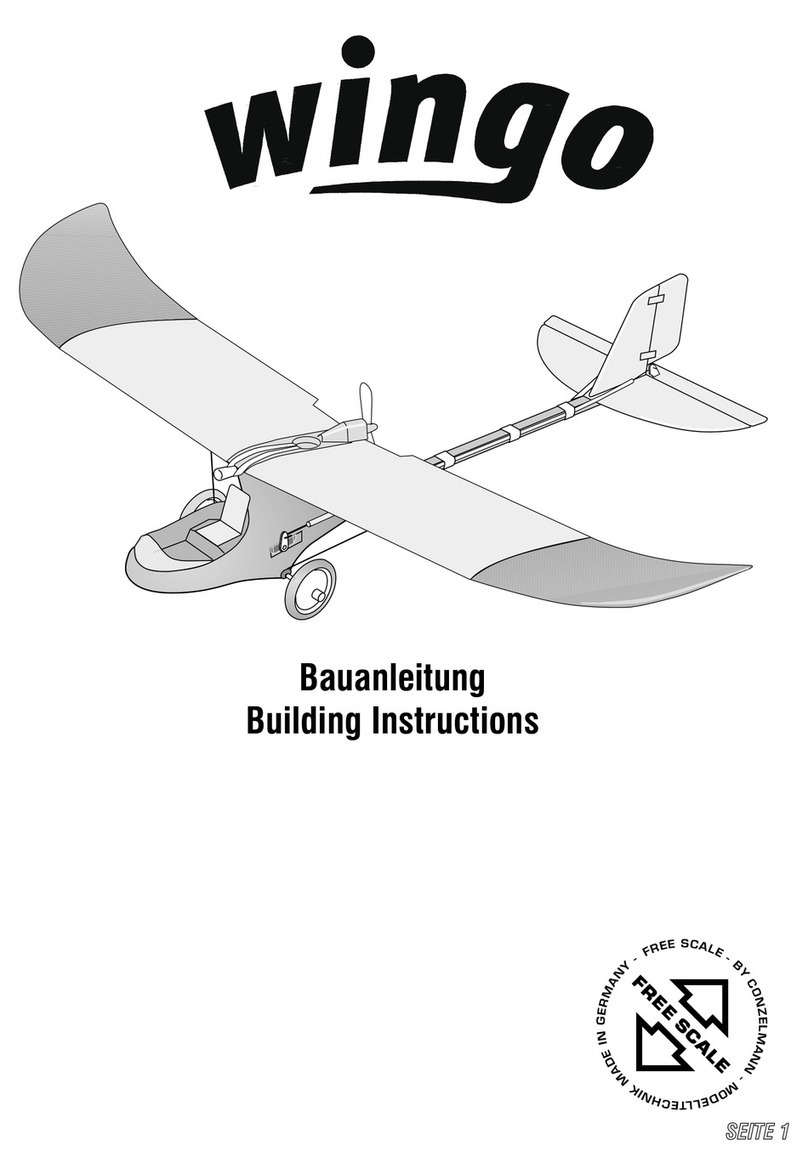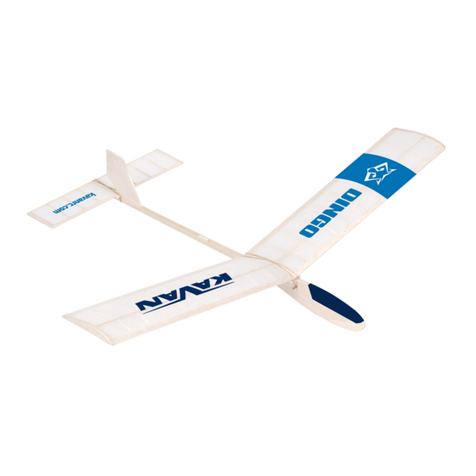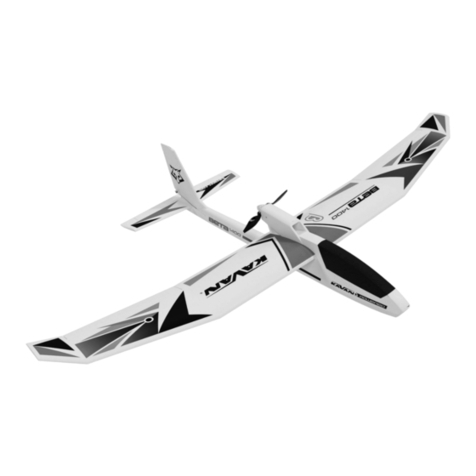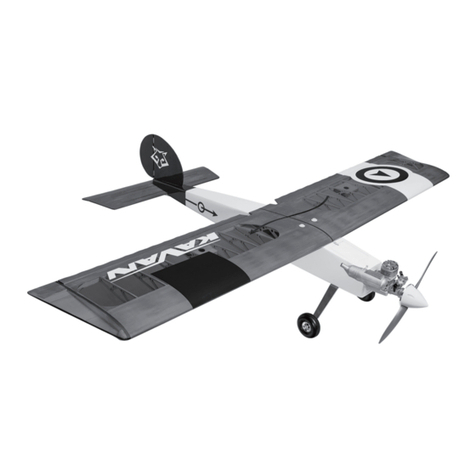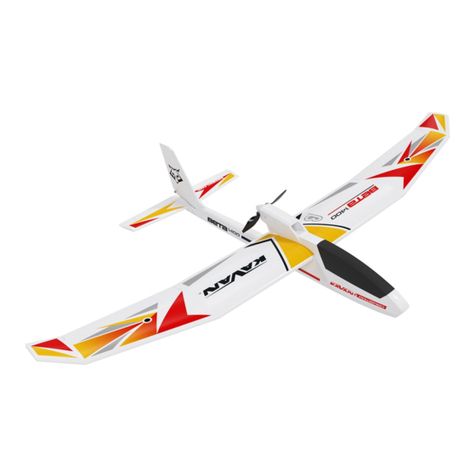
9
které si potahování „nacvičíte“. VOP potáhněte nej-
prve zdola jedním pruhem papíru uříznutým tak, aby
po obvodu byl všude přesah aspoň 10 mm – lepidlem
natřete náběžnou a odtokovou lištu a všechna žebra.
Papír přiložte na kostru a opatrně přihlaďte (pokud
používáte lepení lakem, po přiložení papíru na kostru
jej přilakujte po celé ploše řídkým lepícím lakem). Po
zaschnutí lepidla (laku) potahový papír po obvodu
ořízněte tak, aby zůstal přesah 4-5 mm. Přesahující
papír ohněte dle hrany a přilepte (přilakujte) ke kostře.
Poté VOP potáhněte stejným způsobem jedním pru-
hem papíru shora – lepidlem natřete náběžnou a od-
tokovou lištu, hlavní nosník, střední balsovou výplň a
koncová žebra. Šikmá balsová žebra nenatírejte!
Křídlo: Křídlo potáhněte 4 pruhy papíru, které nastří-
háte s přesahem aspoň 10 mm po celém obvodu (ne-
zapomeňte, že pruhy pro horní stranu křídla musejí být
širší – horní strana křídla je klenutá). Potahovat začněte
opět zespodu – lepidlo naneste na náběžnou a odto-
kovou lištu a všechna žebra, přiložíte pruh papíru na
polovinu křídla a papír přihlaďte prsty ke kostře. Stej-
ným způsobem potáhněte zespodu i druhou polovinu
křídla. Po zaschnutí lepidla (laku) potahový papír po
obvodu ořízněte tak, aby zůstal přesah 4-5 mm. Přesa-
hující papír ohněte dle hrany a přilepte (přilakujte) ke
kostře. Na okrajích zakřivených ploch je nutno přesa-
hující papír nařezat na krátké (4-8 mm) úseky a ty poté
postupně přilepit/přilakovat.
Poté obdobným způsobem potáhněte dvěma pruhy
papíru i horní stranu křídla – lepidlo naneste na náběž-
nou a odtokovou lištu, hlavní nosník a všechna žeb-
ra. Přesahující papír již známým postupem ořízněte,
ohněte dle hrany a přilepte (přilakujte) ke kostře.
Ocasní nosník můžete pro zvýšení pevnosti rovněž po-
táhnout papírem (4 pruhy s malým přesahem postup-
ně zespodu, z obou boků na konec shora); hlavici tru-
pu není potřeba potahovat. Potah křídla a VOP je poté
možno vypínat zředěným napínacím lakem. Jakmile
je potah rovnoměrně napnutý (po 1-2 vrstvách laku),
můžete přilakovat barevné papírové doplňky – a po-
kračovat v lakování.
Celý model nalakujte za sucha a teploty nad 20°C (ně-
které druhy laků mají tendenci při nižší teplotě a vysoké
vlhkosti vzduchu bělat – pokud se tak stane, zpravidla
pomůže přemístění do suchého a teplého prostředí a
opatrné přetření modelu čerstvým ředidlem používa-
ným pro ředění laku), celkem 3-5 vrstev velmi řídkým
lakem. Na trup po natření bezbarvým lakem a násled-
ném přebroušení můžete přilakovat barevné papírové
doplňky - vyznačení kabiny apod. Mezi jednotlivými ná-
těry necháme lak několik dnů schnout – sledujete také,
zda se křídlo nebo VOP nekroutí. V případě, že by došlo
k většímu deformování, je nutno takový díl po každém
lakování položit na rovnou desku chráněnou plastovou
fólií, zatížit (opět pomohou časopisy vložené do plasto-
vého sáčku) a nechat důkladně zaschnout. Jako posled-
ní vrstvu můžete nanést řídký lesklý lak.
Samolepky nalepujte až nakonec na nalakovaný model.
Konečné sestavení modelu a vyvážení
Na levý bok hlavice trupu upevněte bočním vlečný
háček 39 pomocí 2 vrutů 38 v poloze dle stavebního
výkresu (vlečný háček je nastavitelný – při silnějším
větru se posunuje směrem dopředu, při slabém větru
směrem dozadu tak, aby model během vleku hladce
stoupal v plynulém oblouku).
Špičkou hrotitého modelářského nože opatrně vy-
řízněte do kýlovky 29 a směrovky 41 drážky pro závěsy
směrovky 45 z mosazného plechu. Závěsy vlepte vte-
řinovým lepidlem do směrovky a poté do kýlovky tak,
aby mezi směrovkou a kýlovkou byla malá štěrbina
umožňující směrovku vychylovat.
Křídlo i vodorovnou ocasní plochu připoutejte gumou
dodávanou ve stavebnici. Na každém konci poutací
gumy uvažte „očko“, které pak navléknete na poutací
kolík. Do hlavice modelu vyvrtejte (dle stavebního vý-
kresu) otvor do schránky pro dodatečnou zátěž (není
součástí stavebnice) – při použití broků by měl mít
průměr 5mm. Do schránky nasypte takové množství
zátěže, aby trup modelu podepřeného prsty ze spodu
pod křídlem v těžišti (na stavebním výkresu označeno
šipkou) se ustálil ve vodorovné poloze. Otvor v hlavici
po vyvážení přelepte pruhem samolepicí pásky, aby se
zátěž nevysypala.
Přesné vyvážení modelu je nezbytně nutné pro správ-
né zalétání modelu - nesprávně vyvážený model bude
obtížné seřídit nebo nebude vůbec letuschopný.
ZALÉTÁNÍ MODELU
Znovu zkontrolujte správnou polohu těžiště a nemá-
te-li příliš zborcené křídlo nebo vodorovnou ocasní
plochu modelu. Model zalétávejte za klidného, bez-
větrného počasí - nejlépe navečer. Model uchopte pod
křídlem a s přídí lehce skloněnou k zemi jej s mírným
švihem vypusťte. Sledujte jeho let. Houpá-li model,
přidejte ještě zátěž do hlavice. Sestupuje-li příliš str-
mě dolů, zkontrolujte vyvážení. Je-li v pořádku, pod-
kládejte VOP vzadu pod poutacím kolíkem tenkými
podložkami tak dlouho, až model plynule klouže k
zemi. Po zaklouzání klapku směrovky 41 vychylte asi 2
mm doleva (při pohledu od ocasu ve směru letu). Díky
tomu by měl nyní model po vypuštění létat ve velkých
levých kruzích, zatímco při vleku by jej tah působící na
nesouměrně umístěný boční vlečný háček měl udržo-
vat v přímém letu.
Po zaklouzávání můžete DARU zkusit vlekat na silo-
novém vlečném lanku (rybářském vlasci) dlouhém
25-50 m. Vlečné lanko je třeba nejprve připravit: Ke
konci lanka na „straně modelu“ přivažte kovový krou-
žek (dračí smyčka je velmi dobrý druh uzlu pro tento
účel) a praporek (kousek červené látky, který lanko
zviditelňuje při vleku a pomáhá při vyhledávání jeho
konce v trávě). Kroužek zachyťte za vlečný háček, lan-
